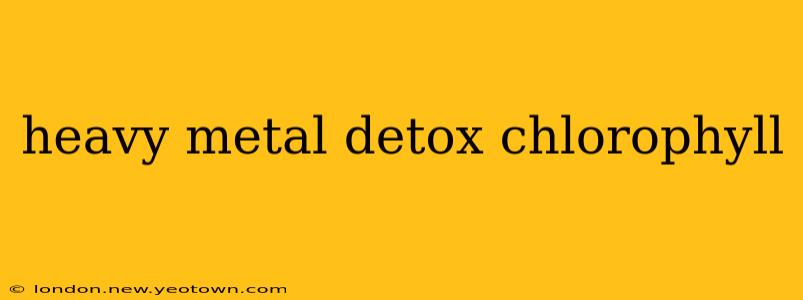The human body is a remarkable machine, constantly working to maintain balance. But sometimes, it faces challenges it wasn't designed to handle—like exposure to heavy metals. These toxins, often accumulating from environmental factors or dietary choices, can wreak havoc on our health. Enter chlorophyll, the vibrant green pigment in plants, touted by many as a natural heavy metal detoxifier. But does it really work? Let's dive into the science and explore the possibilities.
Imagine this: you're a detective investigating a crime scene, and the clues point to a hidden culprit—heavy metals slowly poisoning the body. These metals, like mercury, lead, cadmium, and arsenic, can accumulate over time, leading to a range of health problems. The symptoms can be subtle at first—fatigue, headaches, digestive issues—but as the levels rise, the consequences can be severe, impacting the nervous system, kidneys, and even the brain.
This is where the intriguing possibility of chlorophyll comes in. This natural compound, crucial for photosynthesis in plants, has a unique molecular structure that some believe allows it to bind to heavy metal ions. This binding, the theory goes, allows the body to more easily eliminate these toxins through excretion.
Does Chlorophyll Bind to Heavy Metals?
This is the million-dollar question, and the answer is…complicated. While some studies suggest chlorophyll's potential to chelate (bind) heavy metals in vitro (in a laboratory setting), the evidence for its effectiveness in vivo (in living organisms) is less conclusive. Many studies are small or lack rigorous methodology. What we do know is that chlorophyll's effectiveness likely depends on several factors, including:
- The type of chlorophyll: Different types of chlorophyll (like chlorophyll a and chlorophyll b) may have varying chelating capabilities.
- The type of heavy metal: Chlorophyll might bind more effectively to some metals than others.
- Dosage and duration of use: Sufficient doses over a significant period might be necessary to see noticeable effects.
- Individual factors: Factors like gut health and overall body metabolism can influence how well chlorophyll is absorbed and utilized.
What are the Benefits of Chlorophyll?
Beyond the potential heavy metal detoxification, chlorophyll boasts several other potential health benefits supported by more robust research:
- Antioxidant properties: Chlorophyll demonstrates antioxidant activity, potentially protecting cells from damage caused by free radicals.
- Anti-inflammatory effects: Some studies suggest chlorophyll may help reduce inflammation.
- Improved blood sugar control: Preliminary research suggests a potential role in regulating blood sugar levels.
- Wound healing: Chlorophyll may aid in wound healing, possibly due to its antiseptic and anti-inflammatory properties.
How Much Chlorophyll Should I Take for Detox?
There's no universally agreed-upon dosage for chlorophyll for heavy metal detoxification. The amount you might need will vary depending on factors mentioned earlier. It's crucial to consult with a healthcare professional before using chlorophyll for detoxification or any other health purpose. They can help determine a safe and appropriate dose based on your individual needs and health status. Self-treating can be risky, especially when dealing with heavy metal toxicity.
Is Chlorophyll a Miracle Cure for Heavy Metal Poisoning?
No. Chlorophyll is not a magic bullet for heavy metal poisoning. Severe heavy metal toxicity requires professional medical intervention, often involving chelation therapy administered by trained professionals. Chlorophyll, at best, might play a supporting role as part of a holistic approach to wellness, particularly in situations of mild exposure.
Can I Use Chlorophyll for Chelation Therapy?
No. Chelation therapy is a medical procedure that involves the use of specific medications to remove heavy metals from the body. Chlorophyll is not a substitute for chelation therapy performed under the supervision of a medical professional.
What are the Side Effects of Chlorophyll?
Generally, chlorophyll is considered safe for consumption. However, some individuals may experience mild side effects such as:
- Green-colored stool: This is a harmless side effect.
- Diarrhea or constipation: These are less common but possible side effects.
- Allergic reactions: Though rare, allergic reactions are possible.
If you experience any adverse effects, stop taking chlorophyll and consult a doctor.
Conclusion
Chlorophyll's role in heavy metal detoxification remains an area of ongoing research. While its potential in this area is intriguing, it's crucial to view it within a broader context of overall health and wellness. A healthy diet, regular exercise, and stress management play crucial roles in supporting detoxification processes. If you have concerns about heavy metal exposure or toxicity, consult a healthcare professional for proper diagnosis and treatment. They can assess your individual needs and determine the most appropriate course of action. Remember, when it comes to your health, informed choices based on scientific evidence and professional guidance are paramount.

